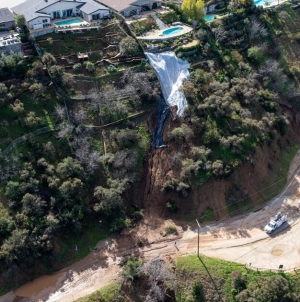-
Shark monitoring system that pings California lifeguards is in trouble - March 29, 2024
-
A portion of Mulholland Drive, damaged by mudslides in winter storms, reopens - May 26, 2024
-
‘Maybe You Don’t Want to Win’ - May 26, 2024
-
Donald Trump Putting Law Enforcement in Danger: Attorney - May 26, 2024
-
Avoid the waters of these 5 L.A. County beaches this holiday weekend, public health officials say - May 26, 2024
-
Bawdy Comedy ‘Anora’ Wins Palme d’Or at Cannes Film Festival - May 26, 2024
-
Map Shows Heat Wave Zone Spread Into Five New States - May 26, 2024
-
Azusa police arrest suspected slingshot-wielding vandal - May 25, 2024
-
Donald Trump Hammers Judge Ahead of Jury Instructions - May 25, 2024
-
Sometimes U.S. and U.K. Politics Seem in Lock Step. Not This Year. - May 25, 2024
Shark monitoring system that pings California lifeguards is in trouble
Here’s something California beachgoers may not know: When some great white sharks get within about 100 yards of certain state beaches, lifeguards get a text alert.
A Cal State Long Beach program developed this unique system about six years ago, and hundreds of juvenile white sharks have since been tagged for monitoring.
But the program is at risk of shutting down after running out of state funding.
The Shark Lab at Cal State Long Beach initially received $3.75 million in state funding in 2018 to set up the program, which tracks juvenile white sharks along California’s coastline, with researchers hoping the monitoring would increase safety at beaches and more broadly help the public understand the sea creatures better.
The money has helped researchers tag 300 juvenile sharks — with about 235 still being actively monitored — and send data on their whereabouts and habits back to lifeguards at beaches stretching from Morro Bay to the Mexican border, said Chris Lowe, a professor of marine biology and director of the Shark Lab.
The team initially tracked the sharks using 120 underwater acoustic receivers about 100 yards off the beach. Divers would collect data from the receivers about once a month and send it back to lifeguards. By that point, the information was usually outdated.
Over the years, the program added tracking buoys to the water, “which give lifeguards real-time data,” Lowe said.
“So now, when a tagged shark swims by one of these buoys … it sends the lifeguards a text alert,” Lowe said. “And then they can click on that text alert, it takes them to a website, and then they can learn all about that shark. How big is it, where has it been, what beaches has it visited, how long has it been at their beach?”
The technology serves less as an “early warning system” than a scientific tool to help lifeguards “better manage beaches,” Lowe added.
Funding was intended to last the research team five years, Lowe said, but it was able to extend the money an extra year. The team of 15 people, including paid students, operates on a budget of roughly $1 million per year.
Lowe said he had talked with state legislators about earmarking more money to continue the program over the next several years. But the state’s dire budget outlook has halted extra spending amid a projected deficit of at least $38 billion.
Long Beach Democratic state Sen. Lena Gonzalez’s office said she was aware that Cal State campuses are dealing with funding challenges this year, and that the Shark Lab’s alert system “seems to also face financial shortfalls.”
Gonzalez’s office did not say whether the senator would push for funding for the lab in the budget. Assemblymember Josh Lowenthal (D-Long Beach) did not immediately respond to requests for comment.
Without another infusion of $7 million to continue the program, Lowe worries that the scientific progress could stall out. He said that for the program to survive the lab would have to find private or foundation funds until the state budget recovered.
The tracking has helped bolster drone research that shows how often surfers and other beachgoers are sharing the water with sharks, most often without incident. That in turn has helped to chip away at misconceptions that sharks are inherently always dangerous and that beaches should be closed when they are nearby.
Lowe said the data-collection process has helped save coastal communities millions of dollars each year because beaches are staying open more often even after lifeguards get alerts of sharks in the water. Researchers are also beginning to understand why sharks flock toward certain beaches, and what their food supply says about the marine ecosystem at large.
“That information is valuable not just to lifeguards, but to the public,” Lowe said. “Because they begin to better understand what the sharks are doing out there and why they don’t pose as big a risk as we once thought.”
Meanwhile, the research effort has become a major attraction and recruiting plug for prospective students looking to study marine biology at Cal State Long Beach.
New funding would help the team tag more sharks and upgrade some of the transmitters, Lowe said, while continuing to educate the public on marine conservation and shark habits.
“When shark incidents do occur, and they will continue to occur — shark bites will still happen — people will have an understanding of the rarity of those circumstances,” he said. “If we can’t run these kinds of programs in California, I don’t know where we could.”
Source link































